Project Financial Management Report: Investment Decision Analysis
VerifiedAdded on 2022/10/02
|13
|1745
|60
Report
AI Summary
This report provides a comprehensive analysis of project financial management, evaluating investment options, and exploring key financial concepts. It begins with a case study that assesses three expansion projects using techniques like Net Present Value (NPV), Internal Rate of Return (IRR), and payback period to determine the optimal investment choice. The report then delves into the sources of finance, distinguishing between internal and external funding, and emphasizing the importance of an optimal debt-equity mix. Furthermore, the report examines variance analysis, identifying deviations from budgeted figures and their potential causes in areas like direct materials, labor, and overhead. Finally, it explores various project cost estimation methods, including expert judgment, comparative analysis, top-down, bottom-up, and parametric models, providing a well-rounded overview of project financial management principles and practices.
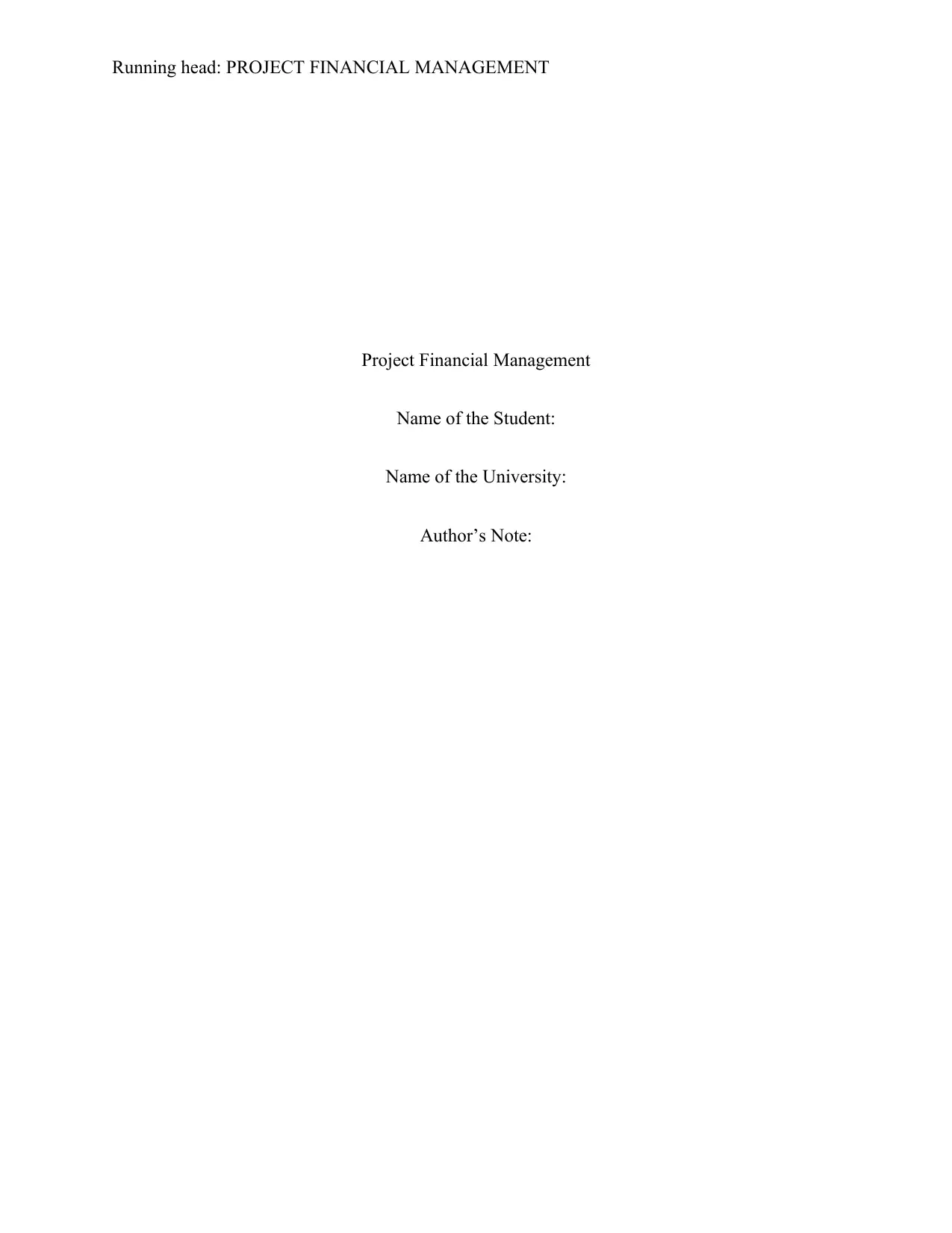
Running head: PROJECT FINANCIAL MANAGEMENT
Project Financial Management
Name of the Student:
Name of the University:
Author’s Note:
Project Financial Management
Name of the Student:
Name of the University:
Author’s Note:
Paraphrase This Document
Need a fresh take? Get an instant paraphrase of this document with our AI Paraphraser
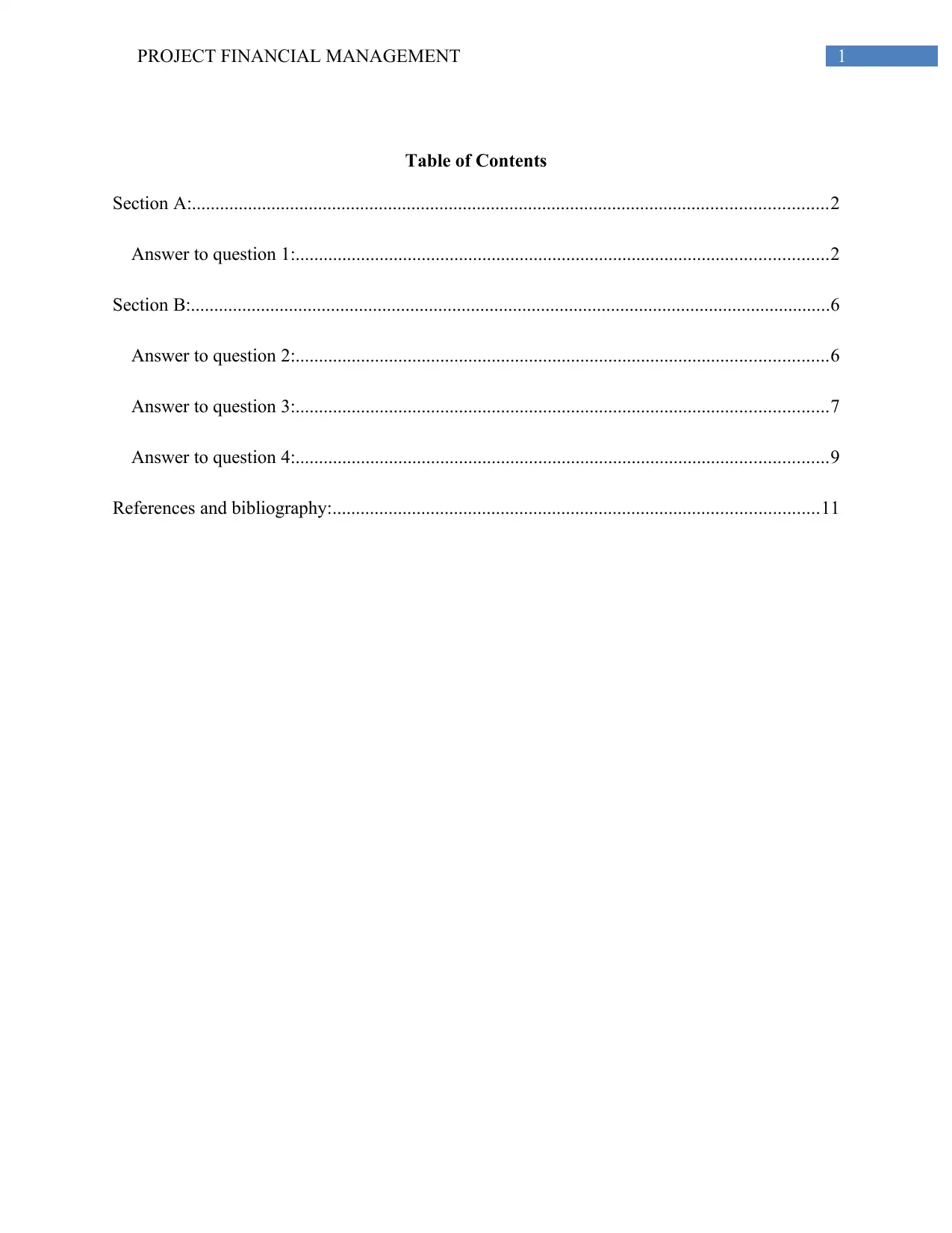
1PROJECT FINANCIAL MANAGEMENT
Table of Contents
Section A:........................................................................................................................................2
Answer to question 1:..................................................................................................................2
Section B:.........................................................................................................................................6
Answer to question 2:..................................................................................................................6
Answer to question 3:..................................................................................................................7
Answer to question 4:..................................................................................................................9
References and bibliography:........................................................................................................11
Table of Contents
Section A:........................................................................................................................................2
Answer to question 1:..................................................................................................................2
Section B:.........................................................................................................................................6
Answer to question 2:..................................................................................................................6
Answer to question 3:..................................................................................................................7
Answer to question 4:..................................................................................................................9
References and bibliography:........................................................................................................11
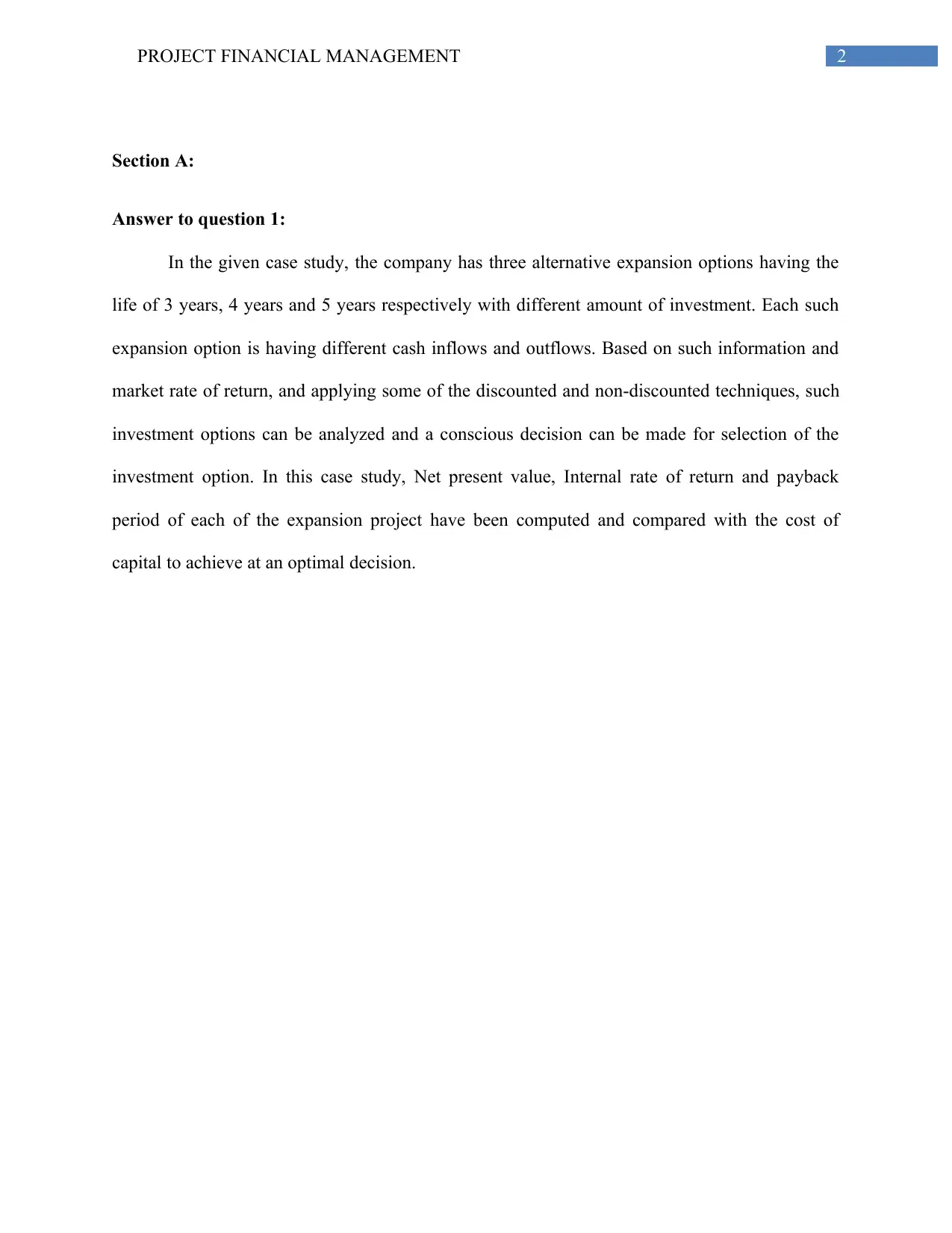
2PROJECT FINANCIAL MANAGEMENT
Section A:
Answer to question 1:
In the given case study, the company has three alternative expansion options having the
life of 3 years, 4 years and 5 years respectively with different amount of investment. Each such
expansion option is having different cash inflows and outflows. Based on such information and
market rate of return, and applying some of the discounted and non-discounted techniques, such
investment options can be analyzed and a conscious decision can be made for selection of the
investment option. In this case study, Net present value, Internal rate of return and payback
period of each of the expansion project have been computed and compared with the cost of
capital to achieve at an optimal decision.
Section A:
Answer to question 1:
In the given case study, the company has three alternative expansion options having the
life of 3 years, 4 years and 5 years respectively with different amount of investment. Each such
expansion option is having different cash inflows and outflows. Based on such information and
market rate of return, and applying some of the discounted and non-discounted techniques, such
investment options can be analyzed and a conscious decision can be made for selection of the
investment option. In this case study, Net present value, Internal rate of return and payback
period of each of the expansion project have been computed and compared with the cost of
capital to achieve at an optimal decision.
⊘ This is a preview!⊘
Do you want full access?
Subscribe today to unlock all pages.

Trusted by 1+ million students worldwide
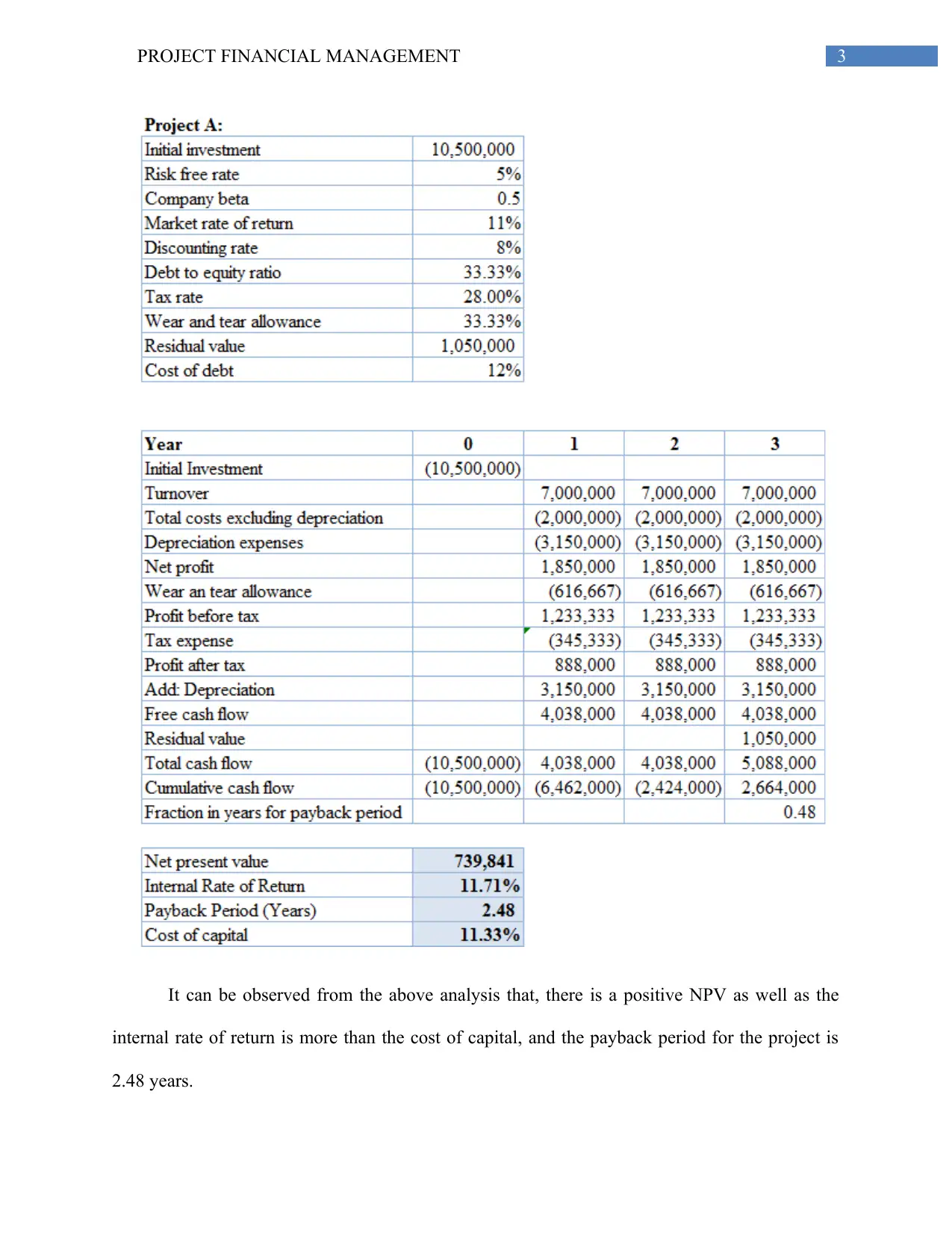
3PROJECT FINANCIAL MANAGEMENT
It can be observed from the above analysis that, there is a positive NPV as well as the
internal rate of return is more than the cost of capital, and the payback period for the project is
2.48 years.
It can be observed from the above analysis that, there is a positive NPV as well as the
internal rate of return is more than the cost of capital, and the payback period for the project is
2.48 years.
Paraphrase This Document
Need a fresh take? Get an instant paraphrase of this document with our AI Paraphraser
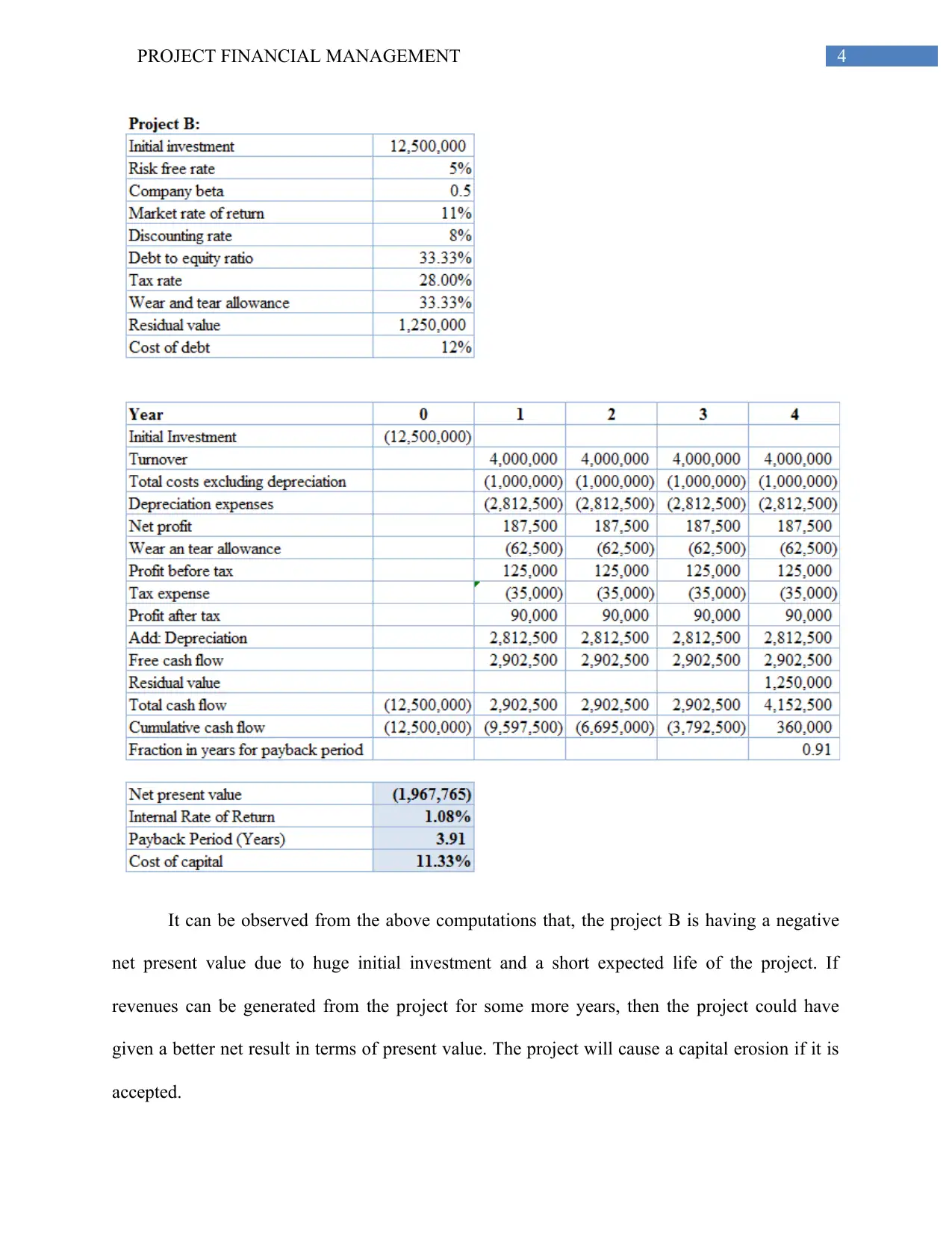
4PROJECT FINANCIAL MANAGEMENT
It can be observed from the above computations that, the project B is having a negative
net present value due to huge initial investment and a short expected life of the project. If
revenues can be generated from the project for some more years, then the project could have
given a better net result in terms of present value. The project will cause a capital erosion if it is
accepted.
It can be observed from the above computations that, the project B is having a negative
net present value due to huge initial investment and a short expected life of the project. If
revenues can be generated from the project for some more years, then the project could have
given a better net result in terms of present value. The project will cause a capital erosion if it is
accepted.
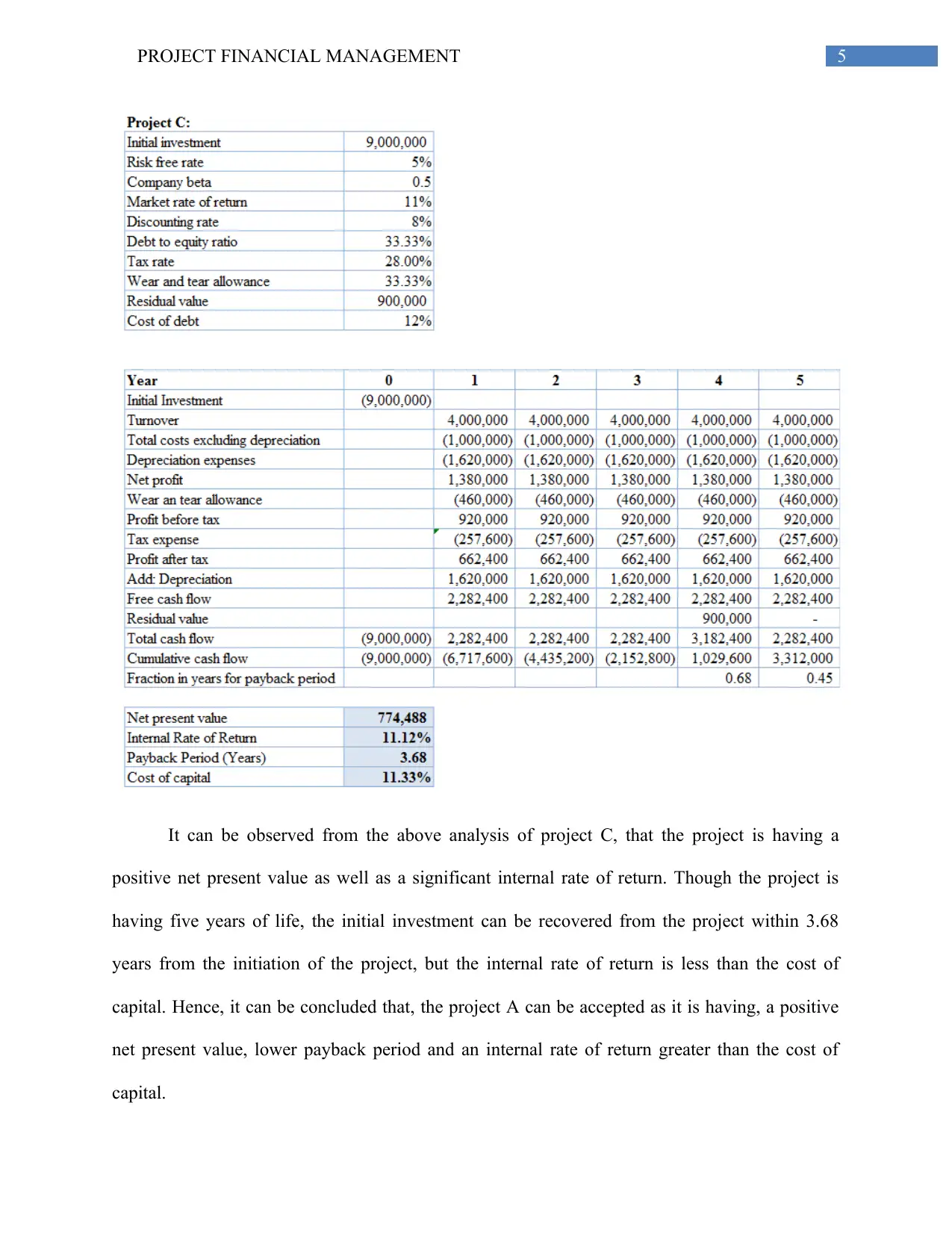
5PROJECT FINANCIAL MANAGEMENT
It can be observed from the above analysis of project C, that the project is having a
positive net present value as well as a significant internal rate of return. Though the project is
having five years of life, the initial investment can be recovered from the project within 3.68
years from the initiation of the project, but the internal rate of return is less than the cost of
capital. Hence, it can be concluded that, the project A can be accepted as it is having, a positive
net present value, lower payback period and an internal rate of return greater than the cost of
capital.
It can be observed from the above analysis of project C, that the project is having a
positive net present value as well as a significant internal rate of return. Though the project is
having five years of life, the initial investment can be recovered from the project within 3.68
years from the initiation of the project, but the internal rate of return is less than the cost of
capital. Hence, it can be concluded that, the project A can be accepted as it is having, a positive
net present value, lower payback period and an internal rate of return greater than the cost of
capital.
⊘ This is a preview!⊘
Do you want full access?
Subscribe today to unlock all pages.

Trusted by 1+ million students worldwide
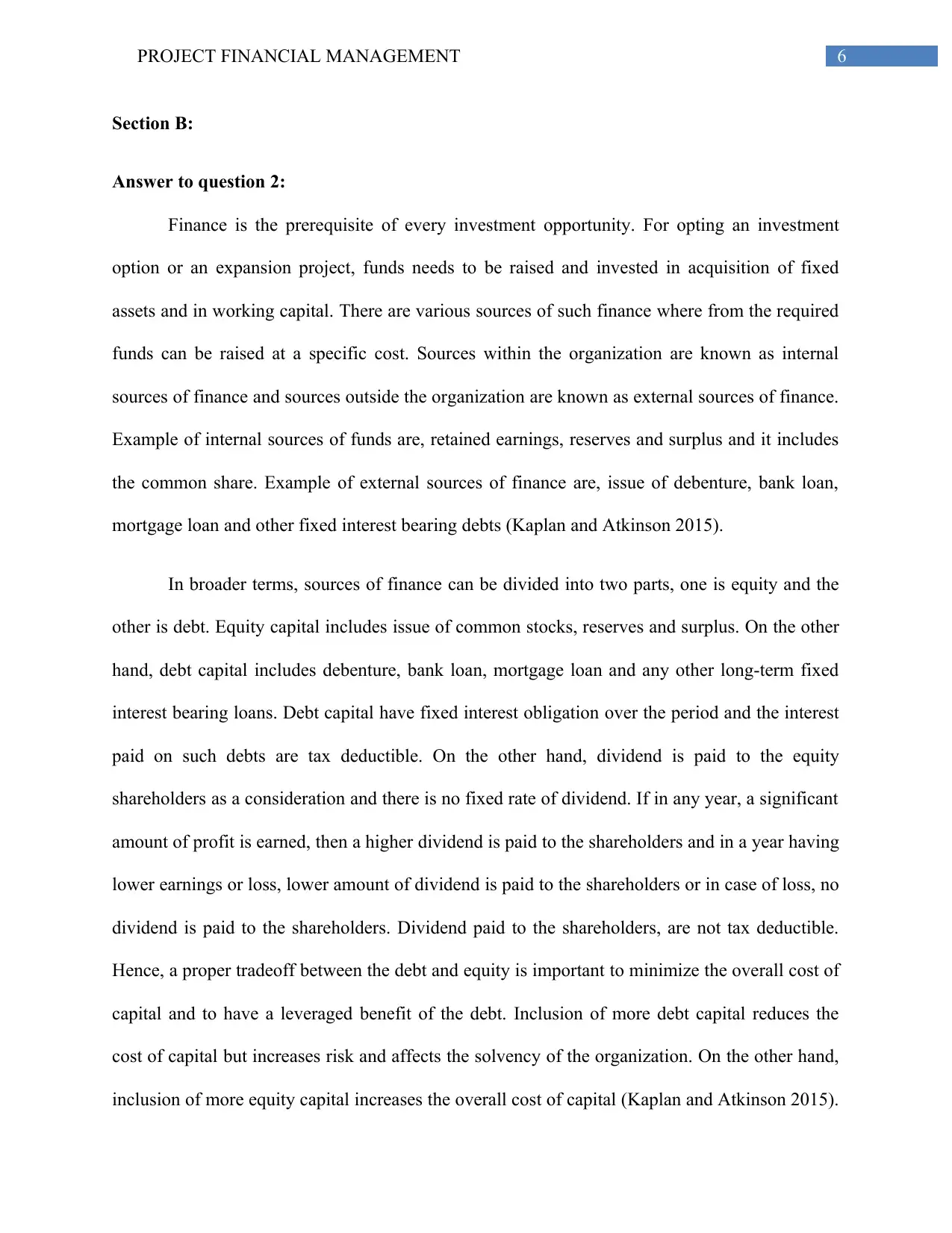
6PROJECT FINANCIAL MANAGEMENT
Section B:
Answer to question 2:
Finance is the prerequisite of every investment opportunity. For opting an investment
option or an expansion project, funds needs to be raised and invested in acquisition of fixed
assets and in working capital. There are various sources of such finance where from the required
funds can be raised at a specific cost. Sources within the organization are known as internal
sources of finance and sources outside the organization are known as external sources of finance.
Example of internal sources of funds are, retained earnings, reserves and surplus and it includes
the common share. Example of external sources of finance are, issue of debenture, bank loan,
mortgage loan and other fixed interest bearing debts (Kaplan and Atkinson 2015).
In broader terms, sources of finance can be divided into two parts, one is equity and the
other is debt. Equity capital includes issue of common stocks, reserves and surplus. On the other
hand, debt capital includes debenture, bank loan, mortgage loan and any other long-term fixed
interest bearing loans. Debt capital have fixed interest obligation over the period and the interest
paid on such debts are tax deductible. On the other hand, dividend is paid to the equity
shareholders as a consideration and there is no fixed rate of dividend. If in any year, a significant
amount of profit is earned, then a higher dividend is paid to the shareholders and in a year having
lower earnings or loss, lower amount of dividend is paid to the shareholders or in case of loss, no
dividend is paid to the shareholders. Dividend paid to the shareholders, are not tax deductible.
Hence, a proper tradeoff between the debt and equity is important to minimize the overall cost of
capital and to have a leveraged benefit of the debt. Inclusion of more debt capital reduces the
cost of capital but increases risk and affects the solvency of the organization. On the other hand,
inclusion of more equity capital increases the overall cost of capital (Kaplan and Atkinson 2015).
Section B:
Answer to question 2:
Finance is the prerequisite of every investment opportunity. For opting an investment
option or an expansion project, funds needs to be raised and invested in acquisition of fixed
assets and in working capital. There are various sources of such finance where from the required
funds can be raised at a specific cost. Sources within the organization are known as internal
sources of finance and sources outside the organization are known as external sources of finance.
Example of internal sources of funds are, retained earnings, reserves and surplus and it includes
the common share. Example of external sources of finance are, issue of debenture, bank loan,
mortgage loan and other fixed interest bearing debts (Kaplan and Atkinson 2015).
In broader terms, sources of finance can be divided into two parts, one is equity and the
other is debt. Equity capital includes issue of common stocks, reserves and surplus. On the other
hand, debt capital includes debenture, bank loan, mortgage loan and any other long-term fixed
interest bearing loans. Debt capital have fixed interest obligation over the period and the interest
paid on such debts are tax deductible. On the other hand, dividend is paid to the equity
shareholders as a consideration and there is no fixed rate of dividend. If in any year, a significant
amount of profit is earned, then a higher dividend is paid to the shareholders and in a year having
lower earnings or loss, lower amount of dividend is paid to the shareholders or in case of loss, no
dividend is paid to the shareholders. Dividend paid to the shareholders, are not tax deductible.
Hence, a proper tradeoff between the debt and equity is important to minimize the overall cost of
capital and to have a leveraged benefit of the debt. Inclusion of more debt capital reduces the
cost of capital but increases risk and affects the solvency of the organization. On the other hand,
inclusion of more equity capital increases the overall cost of capital (Kaplan and Atkinson 2015).
Paraphrase This Document
Need a fresh take? Get an instant paraphrase of this document with our AI Paraphraser
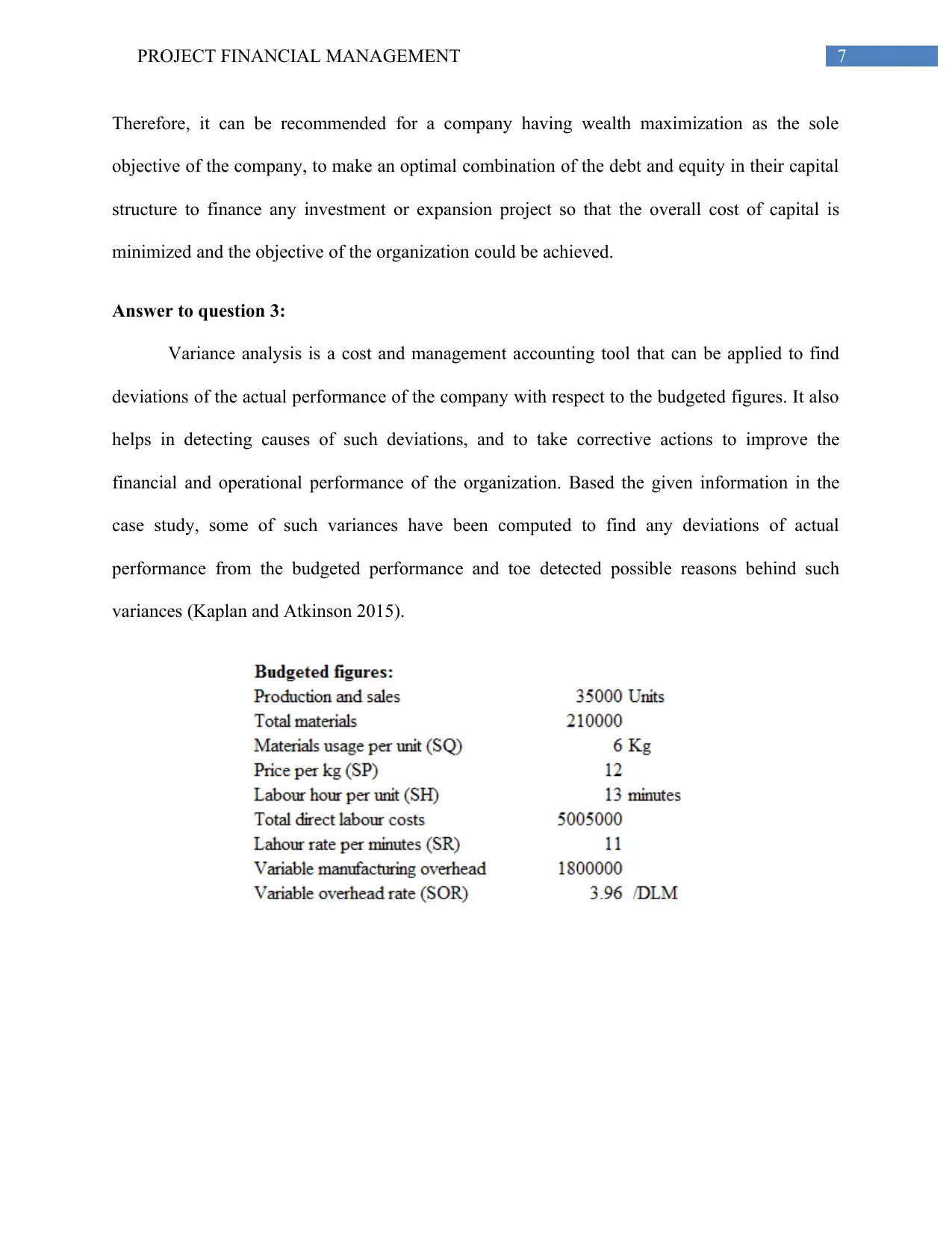
7PROJECT FINANCIAL MANAGEMENT
Therefore, it can be recommended for a company having wealth maximization as the sole
objective of the company, to make an optimal combination of the debt and equity in their capital
structure to finance any investment or expansion project so that the overall cost of capital is
minimized and the objective of the organization could be achieved.
Answer to question 3:
Variance analysis is a cost and management accounting tool that can be applied to find
deviations of the actual performance of the company with respect to the budgeted figures. It also
helps in detecting causes of such deviations, and to take corrective actions to improve the
financial and operational performance of the organization. Based the given information in the
case study, some of such variances have been computed to find any deviations of actual
performance from the budgeted performance and toe detected possible reasons behind such
variances (Kaplan and Atkinson 2015).
Therefore, it can be recommended for a company having wealth maximization as the sole
objective of the company, to make an optimal combination of the debt and equity in their capital
structure to finance any investment or expansion project so that the overall cost of capital is
minimized and the objective of the organization could be achieved.
Answer to question 3:
Variance analysis is a cost and management accounting tool that can be applied to find
deviations of the actual performance of the company with respect to the budgeted figures. It also
helps in detecting causes of such deviations, and to take corrective actions to improve the
financial and operational performance of the organization. Based the given information in the
case study, some of such variances have been computed to find any deviations of actual
performance from the budgeted performance and toe detected possible reasons behind such
variances (Kaplan and Atkinson 2015).
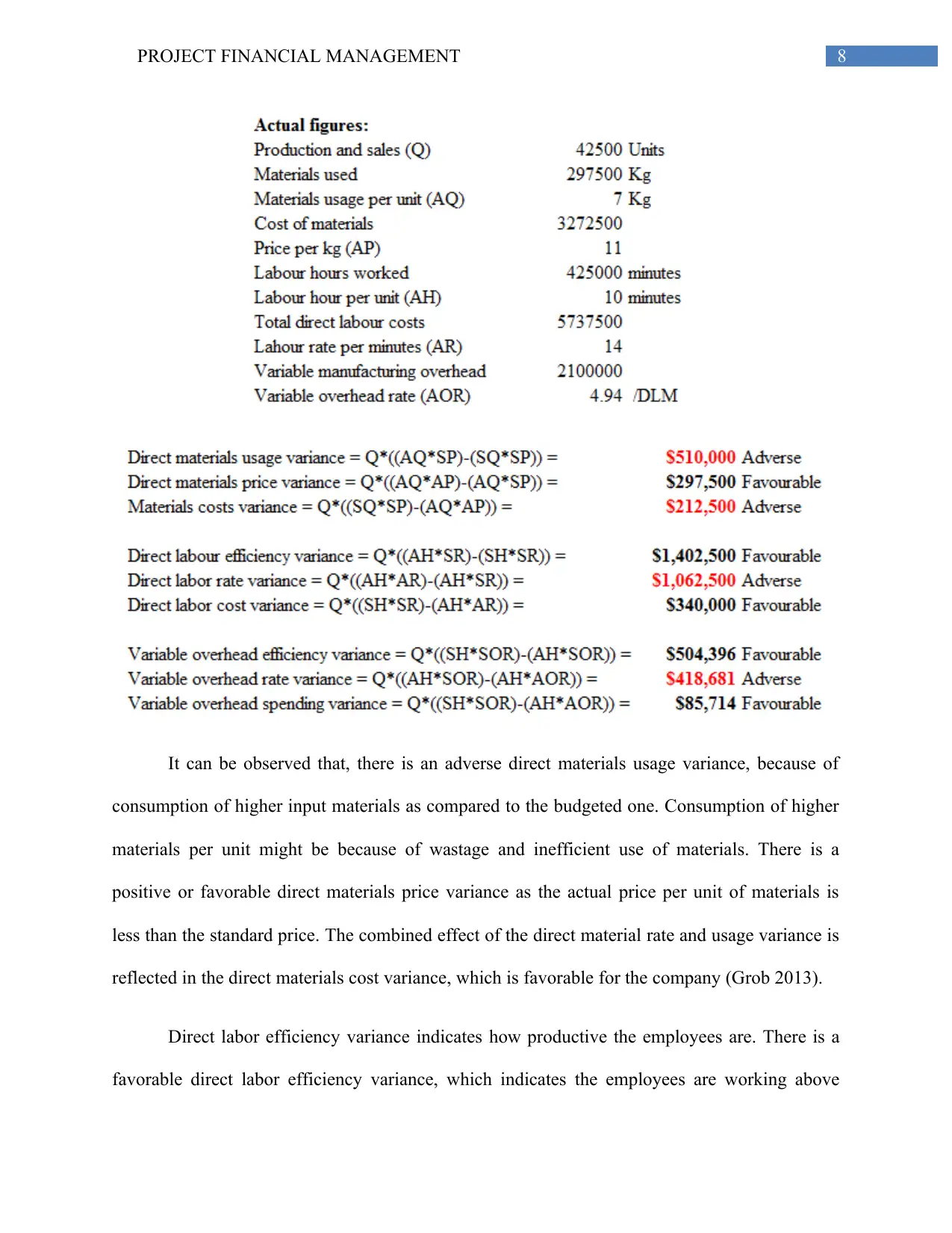
8PROJECT FINANCIAL MANAGEMENT
It can be observed that, there is an adverse direct materials usage variance, because of
consumption of higher input materials as compared to the budgeted one. Consumption of higher
materials per unit might be because of wastage and inefficient use of materials. There is a
positive or favorable direct materials price variance as the actual price per unit of materials is
less than the standard price. The combined effect of the direct material rate and usage variance is
reflected in the direct materials cost variance, which is favorable for the company (Grob 2013).
Direct labor efficiency variance indicates how productive the employees are. There is a
favorable direct labor efficiency variance, which indicates the employees are working above
It can be observed that, there is an adverse direct materials usage variance, because of
consumption of higher input materials as compared to the budgeted one. Consumption of higher
materials per unit might be because of wastage and inefficient use of materials. There is a
positive or favorable direct materials price variance as the actual price per unit of materials is
less than the standard price. The combined effect of the direct material rate and usage variance is
reflected in the direct materials cost variance, which is favorable for the company (Grob 2013).
Direct labor efficiency variance indicates how productive the employees are. There is a
favorable direct labor efficiency variance, which indicates the employees are working above
⊘ This is a preview!⊘
Do you want full access?
Subscribe today to unlock all pages.

Trusted by 1+ million students worldwide
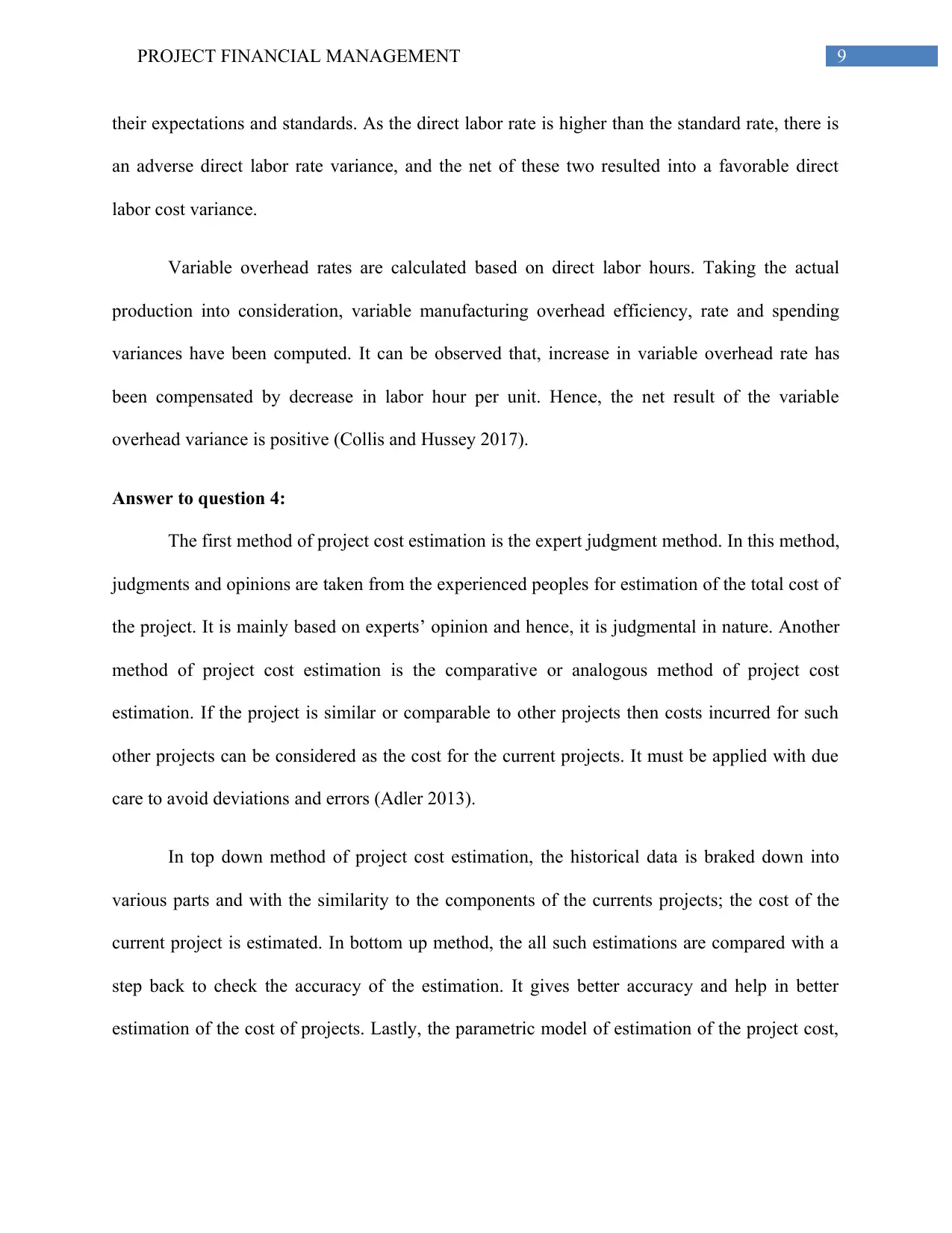
9PROJECT FINANCIAL MANAGEMENT
their expectations and standards. As the direct labor rate is higher than the standard rate, there is
an adverse direct labor rate variance, and the net of these two resulted into a favorable direct
labor cost variance.
Variable overhead rates are calculated based on direct labor hours. Taking the actual
production into consideration, variable manufacturing overhead efficiency, rate and spending
variances have been computed. It can be observed that, increase in variable overhead rate has
been compensated by decrease in labor hour per unit. Hence, the net result of the variable
overhead variance is positive (Collis and Hussey 2017).
Answer to question 4:
The first method of project cost estimation is the expert judgment method. In this method,
judgments and opinions are taken from the experienced peoples for estimation of the total cost of
the project. It is mainly based on experts’ opinion and hence, it is judgmental in nature. Another
method of project cost estimation is the comparative or analogous method of project cost
estimation. If the project is similar or comparable to other projects then costs incurred for such
other projects can be considered as the cost for the current projects. It must be applied with due
care to avoid deviations and errors (Adler 2013).
In top down method of project cost estimation, the historical data is braked down into
various parts and with the similarity to the components of the currents projects; the cost of the
current project is estimated. In bottom up method, the all such estimations are compared with a
step back to check the accuracy of the estimation. It gives better accuracy and help in better
estimation of the cost of projects. Lastly, the parametric model of estimation of the project cost,
their expectations and standards. As the direct labor rate is higher than the standard rate, there is
an adverse direct labor rate variance, and the net of these two resulted into a favorable direct
labor cost variance.
Variable overhead rates are calculated based on direct labor hours. Taking the actual
production into consideration, variable manufacturing overhead efficiency, rate and spending
variances have been computed. It can be observed that, increase in variable overhead rate has
been compensated by decrease in labor hour per unit. Hence, the net result of the variable
overhead variance is positive (Collis and Hussey 2017).
Answer to question 4:
The first method of project cost estimation is the expert judgment method. In this method,
judgments and opinions are taken from the experienced peoples for estimation of the total cost of
the project. It is mainly based on experts’ opinion and hence, it is judgmental in nature. Another
method of project cost estimation is the comparative or analogous method of project cost
estimation. If the project is similar or comparable to other projects then costs incurred for such
other projects can be considered as the cost for the current projects. It must be applied with due
care to avoid deviations and errors (Adler 2013).
In top down method of project cost estimation, the historical data is braked down into
various parts and with the similarity to the components of the currents projects; the cost of the
current project is estimated. In bottom up method, the all such estimations are compared with a
step back to check the accuracy of the estimation. It gives better accuracy and help in better
estimation of the cost of projects. Lastly, the parametric model of estimation of the project cost,
Paraphrase This Document
Need a fresh take? Get an instant paraphrase of this document with our AI Paraphraser

10PROJECT FINANCIAL MANAGEMENT
is a scientific and uses various formulas and functions to estimate the current project costs based
on certain historical data (Adler 2013).
is a scientific and uses various formulas and functions to estimate the current project costs based
on certain historical data (Adler 2013).
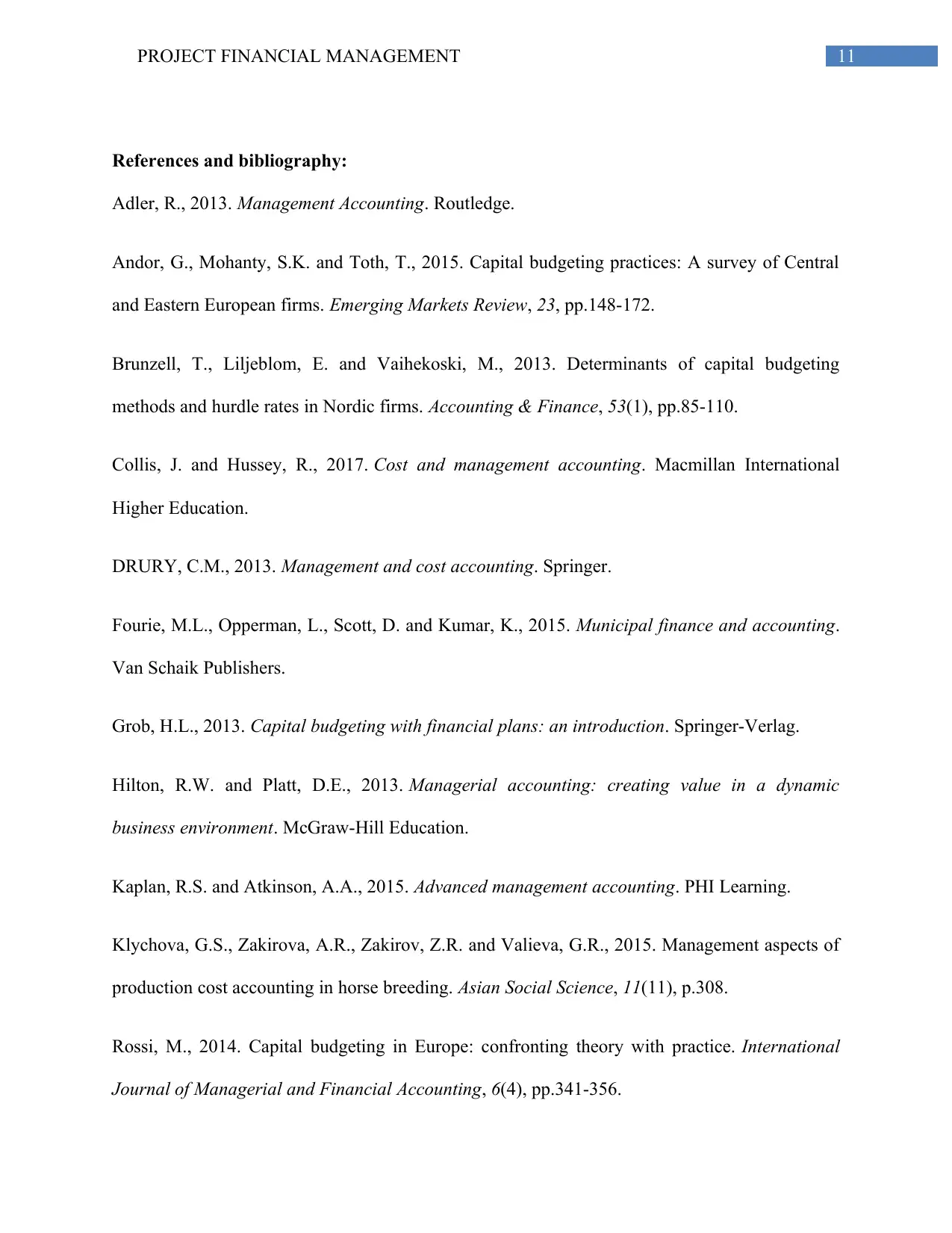
11PROJECT FINANCIAL MANAGEMENT
References and bibliography:
Adler, R., 2013. Management Accounting. Routledge.
Andor, G., Mohanty, S.K. and Toth, T., 2015. Capital budgeting practices: A survey of Central
and Eastern European firms. Emerging Markets Review, 23, pp.148-172.
Brunzell, T., Liljeblom, E. and Vaihekoski, M., 2013. Determinants of capital budgeting
methods and hurdle rates in Nordic firms. Accounting & Finance, 53(1), pp.85-110.
Collis, J. and Hussey, R., 2017. Cost and management accounting. Macmillan International
Higher Education.
DRURY, C.M., 2013. Management and cost accounting. Springer.
Fourie, M.L., Opperman, L., Scott, D. and Kumar, K., 2015. Municipal finance and accounting.
Van Schaik Publishers.
Grob, H.L., 2013. Capital budgeting with financial plans: an introduction. Springer-Verlag.
Hilton, R.W. and Platt, D.E., 2013. Managerial accounting: creating value in a dynamic
business environment. McGraw-Hill Education.
Kaplan, R.S. and Atkinson, A.A., 2015. Advanced management accounting. PHI Learning.
Klychova, G.S., Zakirova, A.R., Zakirov, Z.R. and Valieva, G.R., 2015. Management aspects of
production cost accounting in horse breeding. Asian Social Science, 11(11), p.308.
Rossi, M., 2014. Capital budgeting in Europe: confronting theory with practice. International
Journal of Managerial and Financial Accounting, 6(4), pp.341-356.
References and bibliography:
Adler, R., 2013. Management Accounting. Routledge.
Andor, G., Mohanty, S.K. and Toth, T., 2015. Capital budgeting practices: A survey of Central
and Eastern European firms. Emerging Markets Review, 23, pp.148-172.
Brunzell, T., Liljeblom, E. and Vaihekoski, M., 2013. Determinants of capital budgeting
methods and hurdle rates in Nordic firms. Accounting & Finance, 53(1), pp.85-110.
Collis, J. and Hussey, R., 2017. Cost and management accounting. Macmillan International
Higher Education.
DRURY, C.M., 2013. Management and cost accounting. Springer.
Fourie, M.L., Opperman, L., Scott, D. and Kumar, K., 2015. Municipal finance and accounting.
Van Schaik Publishers.
Grob, H.L., 2013. Capital budgeting with financial plans: an introduction. Springer-Verlag.
Hilton, R.W. and Platt, D.E., 2013. Managerial accounting: creating value in a dynamic
business environment. McGraw-Hill Education.
Kaplan, R.S. and Atkinson, A.A., 2015. Advanced management accounting. PHI Learning.
Klychova, G.S., Zakirova, A.R., Zakirov, Z.R. and Valieva, G.R., 2015. Management aspects of
production cost accounting in horse breeding. Asian Social Science, 11(11), p.308.
Rossi, M., 2014. Capital budgeting in Europe: confronting theory with practice. International
Journal of Managerial and Financial Accounting, 6(4), pp.341-356.
⊘ This is a preview!⊘
Do you want full access?
Subscribe today to unlock all pages.

Trusted by 1+ million students worldwide
1 out of 13
Related Documents
Your All-in-One AI-Powered Toolkit for Academic Success.
+13062052269
info@desklib.com
Available 24*7 on WhatsApp / Email
![[object Object]](/_next/static/media/star-bottom.7253800d.svg)
Unlock your academic potential
Copyright © 2020–2025 A2Z Services. All Rights Reserved. Developed and managed by ZUCOL.





